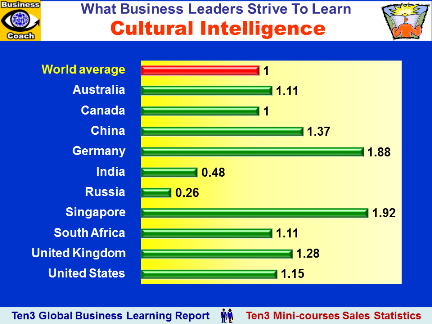|
Contents
1. Introduction To
Cultural Intelligence
CULTURE – Concepts
Related To Cultural Intelligence
Understanding
Cultural Differences
The Power of a
Balanced Wheel
The Wheel of Life
in the Eastern and Western Philosophy
Eastern vs.
Western Philosophy and Values
Cross-cultural
Communication Problems: an Example
Cultural Dimension
Scores: China, Germany, Russia, USA*
Chinese vs.
Americans
Yin-Yang of
Cultural Intelligence
The Power of
Balance
Balancing Your
Business System
Yin and Yang
Yin-Yang of
Communication
5 Basic Elements
Balanced
Organization: 5 Basic Elements
Fast Meditation:
Seven Masters One Path*
2. Success and
Achievement
The Taoist Success
Formula
Yin-Yang of
Achievement
Winning: One Way
Many Paths
Turning
Opportunities To Advantage: 5Ws I-Ching Advice
Creative Problem
Solving: Taking Different Perceptual Positions
3. People
Skills and
Leadership
Understanding
Different Perceptions
4 NLP Perceptual
Positions*
Yin-Yang of
Influencing People
Socratic
Questions*
Solving People
Problems
Conflict
Resolution: 10-Step Yoga Approach
Leader 360
The Tao of
Leadership
Leadership Lessons
by Xenophon
Colin Powell's
Leadership Lessons
Lead by Example*
Yin-Yang of Change
Management
4. Business Success
Strategies
The Tao of
Business Success
10 Management
Lessons from Konosuke Matsushita
Creating a Great
Company: 5 Keys by Narayana Murthy
Competitive
Analysis: 5 Jack Welch's Questions
The Art of War by
Sun Tzu: Defining Competitive Position
The Art of War by
Sun Tzu: Planning
Management by
Consciousness
Yin-Yang of Value
Innovation
Emotions and
Symbolizations Color Can Cause
Creating Customer
Value: 10 Matsushita's Lessons
5. Inclusive
Corporate Culture
Different Types of
a Corporate Culture
Building a Team
Culture
Inspiring Culture
Dell's Fast-paced
Flexible Culture
Kaizen Mindset
Continuous
Improvement Culture: 8 Elements
Suggestion
Systems: Japanese vs. American
Total Quality
Management: Japan vs. West
6. Harnessing the
Power of Diversity
Leveraging
Critical Opposites
4 Cultural
Dimensions
Cultural Dimension
Scores for Some Countries
Yin-Yang of
Leveraging Diversity
Engaging
Cross-functional Teams
Building Strategic
Alliances: Lessons from Toshiba
Mutual Creativity
in Business Partnerships
10 Strategies for
Leveraging Diversity
Annexes
World Religions and Philosophies
Hinduism
Buddhism
Taoism
Christianity
Islam
Ten3 Global Business Self-Learning Report: Country Profiles
Australia,
Brazil*, Canada*, China*, Germany*, India, Indonesia*, Malaysia*,
Russia*, Saudi Arabia*, Singapore*, South Africa, UAE*, UK, USA
|
Sample Smart & Fast Lesson
Slide + Executive Summary
▼

Different Decision Making
Process
Business people arrive at decisions differently
in various cultures and countries.
In the U.S., individuals have more autonomy,
managers solicit input from a team, choose a direction quickly and make
adjustments as the project moves forward.
In China, decisions are made slower, a group
decision is a common practice, but the "boss" has the final say.
In Japan, decisions tend to be made in informal
one-on-one discussions before a formal group meeting.
In France, debate and confrontation are
necessary elements of any decision-making process.
In Sweden, teams learn to make decisions
through lengthy consensus building, which can span many meetings but
eventually leads to strong buy-in and rapid implementation.
According to a recent survey, only 44% of CEOs characterized their
joint venture as "very successful".
The most common cause of failure cited by 50% of CEOs is cultural
differences.

Guidelines for Multicultural Collaboration
-
Learn from generalizations
about other cultures, but don't use those generalizations to
stereotype. Use them rather to understand better and
appreciate other multifaceted human beings.
-
Practice, practice, practice.
-
Don't assume that yours is the
only right way to communicate. Keep questioning your
assumptions about the "right way" to communicate.
-
Communicate trust and build
rapport by talking in your client's preferred mode.
-
Search for ways to make the
communication work, rather than searching for who should
receive the blame for the breakdown.
-
Listen actively and
empathetically. Try to put yourself in the other person's
shoes.
-
Honor others' opinions about
what is going on.
-
Suspend judgment, and try to
look at the situation as an outsider.
-
Honest acknowledgment of the
mistreatment that has taken place on the basis of cultural
difference is vital for effective communication. Use this as
an opportunity to develop trust.
-
Awareness of current power
imbalances is necessary for mutual understanding and working
together.
-
Remember that cultural norms
may not apply to the behavior of any particular individual.
We are all more complicated than any cultural norm could
suggest.
|